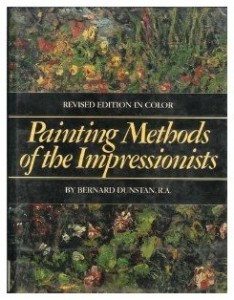My interest in art history died slowly back in art school, where the professors in that subject were historians, not artists. Their lectures were social history lite, with slides of the hoary old standards blinking grayly and grimly on the wavering screen behind. They didn’t talk about the art as art at all–pointing out and comparing themes, techniques, or formal pictorial devices. I suppose they didn’t because, not being practitioners, they were ignorant of such matters.
Art books tend to be written by those same art historians, and in consequence suffer from the same deficiencies. But not all. Some are vastly more knowledgeable than others. One I heartily recommend to art enthusiasts as well as artists is “Painting Methods of the Impressionists” by the British artist and Royal Academician Bernard Dunstan (b. 1920). Dunstan is a real painter, and looks at paintings and the details of their production in a nuts-and-bolts way.
Dunstan is a real painter, and looks at paintings and the details of their production in a nuts-and-bolts way.
The title aims at the economic sweet spot in art books, but to his credit Dunstan casts a wider net. He starts with Constable and Turner, moves on to Courbet and Manet, then to the real Impressionists: Monet, Renoir, and Pissarro; then to the idiosyncratic Degas; then the post-Impressionism of Cezanne and Seurat; then the Americans, Sargent, Cassatt, and Whistler; then the Nabis—Vuillard and Bonnard; and ends with Sickert*. He frankly acknowledges that it’s an eccentric list, but these are artists he likes and is prepared to talk about.
And talk he does, very engagingly. These artists aren’t just names to Dunstan. They represent a line of traditions and influences that are very much alive to him. There is very little history here; mostly he describes technical choices–surfaces, grounds, mediums, brushes, palette knives, color lists, etc–and how these elements present both opportunities and limitations, depending. Learn about how the transition from pigments hand-ground by the artist and stored in pig’s bladders to commercial paints sold in the collapsible tubes familiar to us today affected more than just convenience in plein-air work. Read about the work habits and personal quirks of these people.
A particularly happy feature is that, having put aside any attempt to be comprehensive, Dunstan only bothers to talk about things he thinks are interesting. And so he unfailingly is, from beginning to end. I recommend his book to anyone who is interested in how paintings are made. Painters may learn a thing or two, and lay persons will find a fascinating guide in Dunstan’s clear, accessible voice.
* Sickert was not Jack the Ripper, by the way, despite Patricia Cornwell’s conceptually shoddy and ethically unmoored screed, Portrait of a Killer.